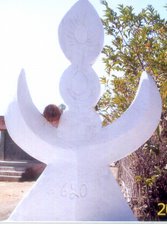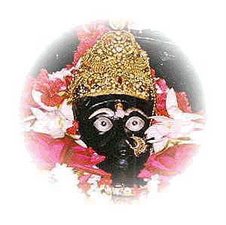Posted by: "Anoop Saha" anoopsaha@yahoo.com anoopsaha
Thu Sep 13, 2007 11:16 am (PST)
http://www.cgnet. in/N1/sj_ myth
Responding to a petition filed by Nandini Sundar and Ramchandra Guha, the Supreme Court has issued a notice to the Chhattisgarh government asking them to explain the rationale behind Salwa Judum.
However the hindu article quotes the bench as saying, "What is wrong in arming the local people to counter the naxal menace?"
Let us try to find out what is wrong in forming a civilian militia by dispelling some of the myths associated with Judum, and propagated shamelessly by the state government and certain sections of the (state) media.
MYTH: Salwa Judum is a spontaneous movement of adivasis against the tyranny of the naxalites.
FACT: It might be a mere coincidence that the first public meeting of Salwa Judum was on June 4 2005, the very same day the state government signed an MoU with Tata steel to set up a steel plant in Bastar. What is not is that the policy of creating and arming local resistance groups is the bedrock of India's anti-insurgency strategy.
In its analysis of the naxal problem, the annual reports of ministry of home affairs mentions "creation of local resistance groups at grass root levels" and "encouraging local resistance groups" as potential counter strategy. These lines are repeated in its 2003-04, 2004-05, and 2005-06 reports with the assurance that the ministry is actively encouraging such methods. (interestingly no such mention is there is in 2006-07 report which is quiet heartening) It is not the first time that village defence commitees were formed in Bastar.
Similar attempts were made unsuccessfully in 1993-94 and then again in 1999. They were tried in Bihar, Jharkhand and Orissa as well to counter the naxalites. Salwa Judum was not limited to forming a civilian militia. It went beyond that, employing the classical techniques of 'strategic hamletting', so (un)successfully adopted earlier in the North-east. The well known strategy involves emptying the people from remote villages to designated camps, cutting the supply line of the rebels, and launching fresh strikes in their strongholds.
Once the villages are emptied, all those who are left behind can be identified as enemy combatants and any force used against them can then be justified.The state's propaganda highlights adivasi dienchantment with the naxalites. Of course there is some truth in the contention that some adivasis do want the naxalites to be driven out of Bastar, out of their lives. It is true that the naxalites can be as exploitative as the state or the thekedaar.
The people do have a right to feel that their lives would have been better in the absence of the naxals. Before driving to any conclusion, it is also important to analyze the events of last 20 years. When the first batch of naxalites came to Bastar, it was a fertile ground for revolutionary mobilization. The only visible face of state was the attrocious police and forest guards. Health and educational standards were low, and are still very bad.
The naxalites got popular support by their small acts, like beating up the guard or ensuring better wages for forest produce. After they were firmly established and gained confidence of the adivasis, the naxals started implementing basic principles of their ideology. These included among other things, a redistribution of land by force. Like all societies in India, the tribal society also had a feudal character.
This implementation- of-ideas phase alienated a section of the adivasis. It is this very "class" of people who lost their land and power in the process, who form the backbone of Salwa Judum. In camp after camp, the most common grouse of SJ third rung leaders against the naxals were, "woh bolte the zameen baant do. Kyon baant de?" (they asked us to distribute our land. Why should we?). Bu this does not mean that the popular support for naxalites were on the wane. The land redistribution earned them far many supporters than enemies. A significant portion of these people are still with the naxalites, and form the part of large coordinated attacks as that on NMDC.The leaders of SJ are all non-adivasis. Salwa Judum also finds popular support among the industrialists of Chhattisgarh (CII, CG chapter), the local thekedaars, RSS, and of course with the Union Ministry of Home Affairs.MYTH: Salwa Judum is a peaceful gandhian movement.FACT: Both leader of opposition in CG assembly, Mahendra Karma, and ex-adviser to Chhattisgarh government, KPS Gill, along with many others have termed SJ as a peaceful Gandhian movement. It is not just a question of etymology. Gandhian definitely does not mean forcing people to leave their homes, creating a unaccountable armed vigilante group, killing all those who dosn't agree with them, and letting a small group of people in charge of huge funds to manage the camps.
The charges of rape/murder against Salwa Judum gangs and the paramilitary fores which augment/support the movement, has been well documented in numerous fact finding reports. Salwa Judum was also accompanied by the draconian law, CSPSA. Some of the provisions of CSPSA is even harsher than that much hated act AFSPA, and it directly targets activists and journalists who report on the maoists activities. CSPSA perfectly gels with the philosophy that anyone who is not with the tyranny of the state is essentially a naxal sympathizer.
One of the most ardent human rights activist of Chhattisgarh, and someone who has been closely involved in public health programs of Chhattisgarh, Dr. Binayak Sen is in jail since May 2007. The fabricated charges against him under CSPSA were found serious enough by the Chhattisgarh high court that denied bail to him.
An alumnus of CMC Vellore, Dr. Binayak Sen played a pivotal role in exposing the true face of Salwa Judum. Cajoled and compromised, most local media outlets in Chhattisgarh parroted the lines of state in reporting his arrest. He is not the only one who is being charged with this draconian act. CSPSA is direct linked with the Salwa Judum campaign. The act is designed to prevent any unwanted criticism of the 'movement', especially by the local people and the local media. Despite this, some have taken a courageous stand in exposing the brutal violence unleashed by Judum militia.
CPJC (Campaign for Peace and Justice in Chhattisgarh) had a convention on 4th september in New Delhi on the civil war situation in Dantewada. One of those who came from Dantewada had been shot at his testicles because he refused to participate in the Salwa Judum rally.
Another person from Vechapal village told us that two women from his village were raped by the paramilitary forces. They were forced to wear the naxalite uniform; their hairs cut and were taken to Jagdalpur jail. Such cases are repeated in almost all the villages in Dantewada district. Earlier this year on March 31, 12 people from Ponjer and Santoshpur villages were murdered by the SPOs in Santoshpur. The sarpanch of Santoshpur (himself an SPO) who was in one of the assaulting parties did a tell-all-interview explicitly claiming that the SPOs and district force people killed 6 of his fellow villagers in front of him and that 2 of the killed were just mahua collectors. The rest were sangham members. Sangham is the unofficial body created by the naxalites in the villages. They are not armed, and merely check the events in the village.
The Santoshpur encounter was highlighted accidentally, because one of the media team from abroad happened to be in Dantewada at the same time. They managed to talk to the scared villagers of Ponjer, who had taken refuge under a tree after evacuating from their village. Perhaps nothing exemplifies the gravity of the situation than the story of this unnamed female inmate of Jagdalpur jail. The Independent Citizens initiative (ICI) in its report says about her, "We met a female inmate of the Jagdalpur Jail who said she had been picked up while accompanying her brother in a cycle, to visit their sister. Her brother was shot dead in front of her and she was first gangraped by the CRPF near the roadside and then sent to the local thana where she was held and gangraped for another ten days, after which she was sent to Jagdalpur Jail. The other women in jail corroborated that when she first arrived, she was so swollen from the sexual torture that she could hardly walk. This woman (whose identity we cannot reveal) is currently charged under the arms act and dacoity."
MYTH: The displacement of adivasis from villages to camps is inevitable, of their own free will, and is to ensure their safety.
FACT: Again a cursory glance at the pattern of displacement belies this argument. Salwa Judum was officially started on June 4, 2005. Not accustomed to any voice of dissent, the naxalites killed 8 villagers in Kotrapal village on June 14 2005. This provided the much needed excuse for the state, and the first camps were established almost immediately.
Although, june 14 incident had a limited influence, by July, at least 15000 tribals were forced to migrate to the camps. What made whole of villages suddenly move to the camps? How was this mass transfer accomplished in flat 15 days? The largest movements of villagers occurred in significant chunks. On diwali eve of 2005, people from at least 100 villages were moved to the camps.What was happening to those who stayed back in the villages. Reports kept coming out about the violent actions by the salwa judum cadres, the SPOs, the police and the reserve batallions like crpf, naga and mizo jawans unleashing brutal violence on them. Women were raped, men were killed, children were maimed, and large amounts of grains and vegetables grown by the adivasis were destroyed. Despite mounting evidence, not a single FIR was lodged against all those associated with SJ. In a more serious lapse, all health and educational facilities were stopped by the state in the villages considered to be rebel strongholds. The sarpanches of some villages have sent a letter on 24th May 2007, reiterating this fact. They claim that all essential services have been suspended in these thousands of villages since the launch of Salwa Judum. If anybody tries to cross the Indravati River and tries to go to the haats, he/she is severely beaten by the SPOs and CRPF men. They walk 80km one way to get a packet of salt. Incientally, most of the haats, which were the main instrument of social and economical exchange of these villagers have been shut down.The state claims that the people had to shift to the camps to save themselves from the murderous assaults by the naxalites.
The naxalites did react violently to the Salwa Judum campaign and the people associated with it were brutally massacred. But the number of persons killed by them still pales in comparision to what has been done in the name of Salwa Judum.Today, more than 50000 people are living in 22 camps in south Bastar district. The conditions of these camps are dismal. Around 60000 adivasis have migrated to the neighbouring states and are facing an acute humanitarian crisis. The entire society is in crisis, and it might take a long time to undo the mistakes committed.
MYTH: Salwa Judum is only possible strategy to counter the increasing threat of naxalites.
FACT: Some Indian states have successfully tackled the left wing extremism in the previous decades. The ideological bases of these movements have also surfaced in almost all parts of the world. The surefire way to tackle such insurgencies is to isolate their legitimate demands, strengthen the panchayati raj institutions, have transparency in all government schemes, and most importantly, empower and address the non-violent grievance mechanism in the country.
The increase in naxalite presence in recent times is directly correlated with the increasing inequality in the society and the mad rush to exploit the limited resources. We have a lovely document that can be our guide to face such scenarios. It is called "the Constitution of India". One of the most tried and tested method to counter the maoist principles is to simply ensure the rights guaranteed by the constitution to each individual. A very basic first step can be to sincerely implement land reforms all across the country. It is possible to isolate some basic demands of the maoist party and they are not dissimilar to what many other political parties and social movements are asking for. Land reforms are one. The other is to amend the 'Land reforms act, 1894'. The third is to public ownership of all natural resources. Fourth is to look into the agricultural distress. These are very easy steps but require tremendous will power in part of the government.
What is also required is to ensure delivery of basic services like education and health in these regions and improvement in quality of governance.As a military strategy also, there are variety of ways to engage the naxalites in battle. Salwa Judum, the entire campaign, represents the abrogation of the responsibility of the state and its security apparatus.
MYTH: Salwa Judum is accompanied by development initiatives by the state government of Chhattisgarh and the government of India.
FACT: As mentioned before, the SJ campaign was started on the very same day on which the state government of Chhattisgarh signed an MOU with the tatas for them to set up a steel plant in Lohandiguda in Bastar. Essar is also setting up a steel plant in Dhurli/Bhansi region of Dantewada.
Both these parties have also demanded lease and mining rights for the vast iron ore reserves in Bailadila. The interest of both these groups lies in the success of the Salwa Judum campaign. According to annual report of Dantewada district collector, Essar ha contributed to establish the Salwa Judum relief camps as model villages. This will ensure that the villages are permanently emptied out, which can be exploited for their mineral wealth at a later date.The people in both these cases are dead against any forced acquisition of their farmland. All the 10 villages of Lohandiguda and 2 villages of Dhurli and Bhansi fall under fifth schedule, and any land acquisition without the express permission of the gram sabha is illegal.
Given that a majority of the farmers (mostly adivasis) were not ready to part with their land, the state devised a unique way to subvert the guidelines. On the day of Gram Sabha, heavy security forces were deployed and the villagers were asked to remain at their homes. Accompanied by police, they were called in one by one in the panchayat building, and asked to sign on the document there.
None of them were allowed to read out the contents of the document. Further section 144 was clamped in some villages during the whole period. Although all outsiders were banned, the grram sabhas were attended by the resident directors of essar steel and tata steel respectively. What is noteworthy is that all the villages, where such drama was played out, have never had any naxalite presence.(documents are available in www.cgnet.in)If education and health are identified as basic developmental indicators, Dantewada is is in a much worse shape now than a few years back. There is massive malnutrition among children in the camps.
The medical facilities are virtually non-existent, and the state has stopped all health care activities in the villages which have not endorsed Salwa Judum. According to a recent team of doctors who visited the camps, “People living in camps suffer from significant untreated morbidity, and seem to receive only periodic or occasional health services. People living in villages on the ‘other side’ are not being provided services at all by the public health system.†I must point out that a couple of years back I met a top district official of Dantewada. According to him, the only redeemable feature about the naxals is that they have never harmed any government campaign on “shiksha and swasthya†(education and health). So the excuse that the health services had to be stopped for the fear of naxalites is bogus at best.Education is in a far worse shape. A large number of paramilitary forces are stationed in government school buildings. Among them are, like Rani Bodli, residential schools where even the girl’s hostel buildings are shared by the security forces. A majority of schools remain closed, and the state govt. granted a general promotion to all students of many villages, because even the examinations could not be conducted. If development means roads and well connectivity, while eight lane wide roads are constructed to join the sites of tata and essar steel plants with state capital, the status of roads connecting many villages have become worse and are in a state of disrepair. The funds under Gram Sadak Yojana remain largely unutilized, or mismanaged in a very large scale.
MYTH: All the displaced adivasis are living in camps. Although the camps have bad living conditions are still better than their villages.
FACT: The state government claims that 644 villages out of a total of 1350 have supported salwa judum wholeheartedly. Approximately 50000 villagers have taken refuge in the 22 relief camps as of August 2007. The state also claims that these 644 villages are targeted by the naxalites, and that is the reason for such large exodus to the camps. A quick tour of the relief camps leads us to believe that the actual number of people in these camps is far less than what is claimed.
The back of the envelope calculations show that the total population of these 644 villages ought to be nearly 3.5 lacs. The big question is, where are the rest of 300000 villagers? Either they are in their village, engaged in farming, bothering least bit about the naxalites. Or they have sided with the naxals, at a whopping ratio of 6:1. Or they preferred to migrate to neighbouring states, away from the ghettoish camps. Indeed, a large number of adivasis have have crossed the borders and shifted to AP and Orissa. Since they are not formally recognised as 'Internally Displaced People' (IDP) by either the state or the international humanitarian existence, many of these are facing life of acute subsistence. There have been repeated calls from people living in these districts to provide some sort of support to these refugees.They chose to take the risk go elsewhere, rather than stay in the camps. These camps, which are supposed to be run very efficiently with massive funds being poured out, are claimed to be dens of vice. The adivasi women are least safe in these camps. The standard of food and medical facilities are awful in a majority of camps. It is important to enquire the massive amounts of relief package being siphoned away. The only source of employment in these camps is working as contract labour on daily wages, or to enroll as an SPO. While a majority of adivasis were engaged in agriculture and collecting minor forest produce, now they are reduced to nothing more than coolies.
MYTH: Salwa Judum is sucessful.
FACT: The metric of success for the Salwa Judum campaign is, in the words of state DGP that the naxalites have themselves admitted to the killing of 500 of their cadres in the salwa judum campaign. But then they have also claimed to have recruited more number of people in last two years from Bastar, than in the previous 20 years.
Far from weakening it, this campaign has given more ammunition to the naxals both in form or personnel and human rights issues. While a large number of 'sangham members' have indeed died, the naxals retain their ability to carry on massively coordinated strikes of forces and civilians. Forget central committee, state committee, zonal committee or its district committee, even a dalam commander (which is the lowest hierarchy among the naxalite armed wing) is there among those '500 naxalites' killed by SJ.
Most organs of the state have claimed repeatedly that the top leadership of naxals has taken refuge in the forests of Dantewada. This most brutal suppression of human rights for seemingly fictitious successes has few parallels in the world, most notably in Darfur, Peru, Sierra Leone and Congo. Salwa Judum fits with the union home ministry's idea of "aiding local resistance groups", that has never shown any success in any part of the country and yet shamelessly employed in all regions of direct conflict for apparent quick results
.On November 14 2006, there was a large rally of nearly 70000 adivasis in Dantewada, shouting slogans against Salwa Judum. If there ever was a popular support for SJ, it had disappeared completely within a few months. A similar rally was taken out in July this year in Cherla village near Konta.The reason that is now cited in some sections for the continuation of SJ is that a quick withdrawal will mean a loss of face for the state government. Given a choice between 'loss-of-face' and large scale societal annihilation and the kind of brutality mentioned in this article (that is merely a tip of the iceberg), it is not very hard to choose.Salwa Judum is continuing, and the violence is showing no signs of abatement.
The policy of arming civilians to counter insurgency has never been discussed in the parliament. Proving once again that famous Edmund Burke hypothesis, All that is necessary for the triumph of evil is for good men to do nothing.
Subscribe to:
Post Comments (Atom)







2 comments:
the tragedy of SJ in dantewada is justifiably linked to the class war. its prosecution of the civilians in context of an (un)declared war. however what is intriguing in naxal influenced area is the proposition that only certain class who are adversely affected by the party's campaign are against that. will this proposition bee an strech? do not the commoners or the class that party clains to represent have some dissent? how does the party resolve it? why shhould the party think that all the people should/must led their shoulder in a "just war". should not people themselves decide the methods of struggle? where is the party leading the people beyond a stiff resistance to what could have been a inevitable humilation, indignity and displacement? what is the line between self defensive violence and arbitary killing? what method does the party adopt to decide its offensive action?
op
well,Mr.Om..i'm not sure,i completely understand what you're trying to say...and neither do i support the naxalite movement completely[i jus don blame the naxals,i dont encourage any1 to be that]..but there us this one remark of urs,for which u need to understand one basic principle.."voice for the voiceless"...poor,deprived and the displaced...whoever it might b,mayb cuz of their socio-cultural background or the complex of income hierarchy,they tend to ACCEPT their helpless situation as "fate"...and they hadly find any hope in anythin else...for them,the only motive will b to survive today..the very poor and the highly deprived do not usually raise a voice..it's only those who have a few things atleast,who r willing,determined and hopeful enough to understand that their situation is "man-made" and not otherwise..n they accordingly volunteer to raise a voice..but those who dont find any hope dont...sooo,in order for them to understand that whatever the movements are:might bring a bright future,is the work of the party,,,thats where the party strategy comes in...those who don agree have to come to find hope as well as trust in these movements,,.and yes,givin a shoulder to a "just-war" is a part of findin a brighter tomorrow...and the justice,..i hope is of some help atleast...
Post a Comment